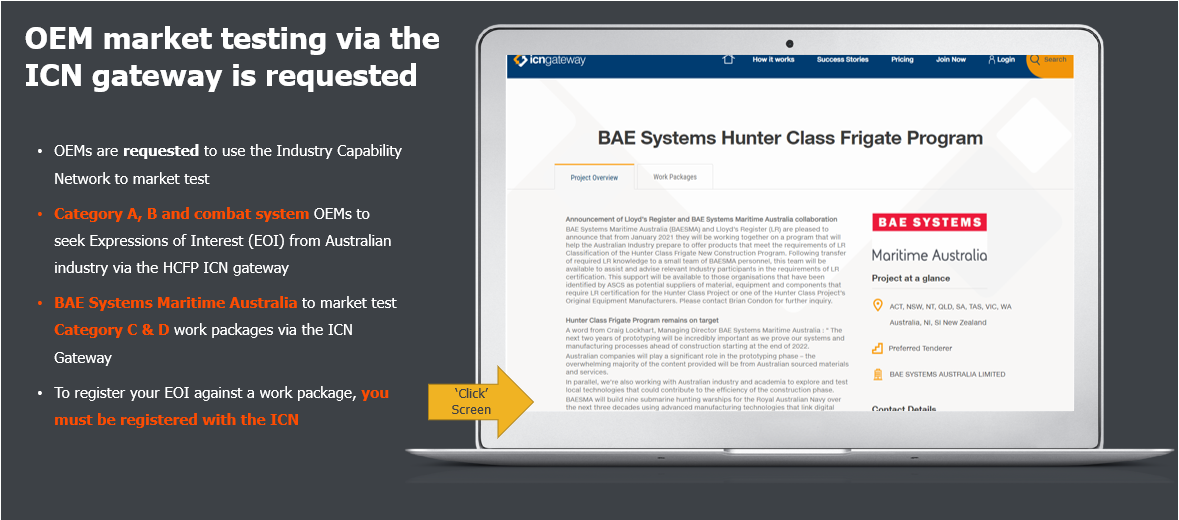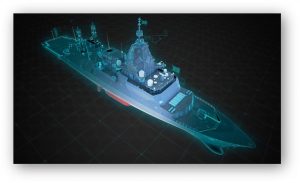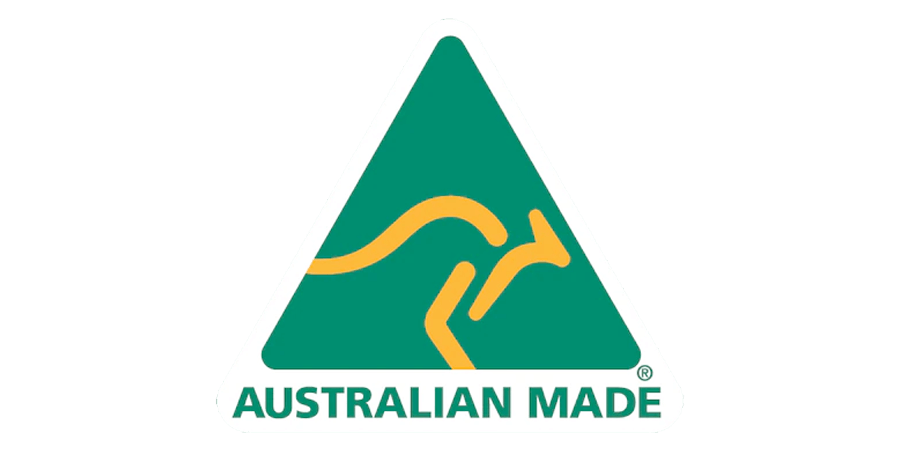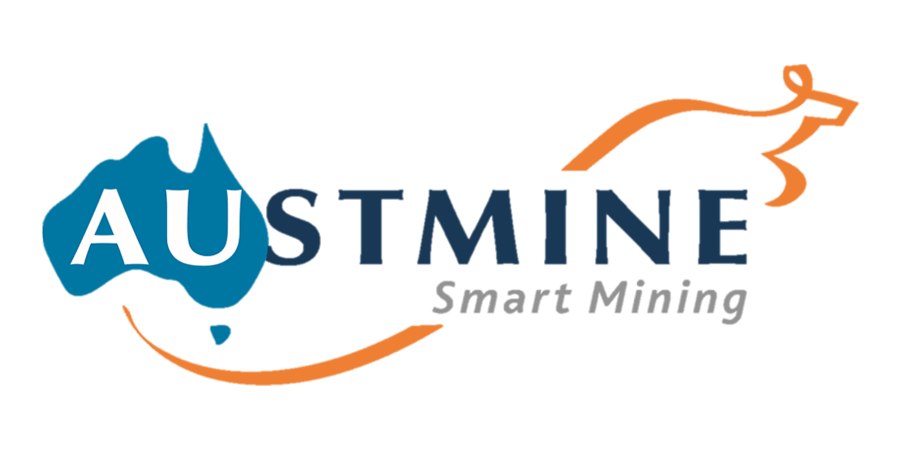BAE Systems Australia Hunter Class Frigate Update
AUSTRALIAN INDUSTRY CAPABILITY (AIC) SME ENGAGEMENT
Hunter Class Frigate Program

Hunter Class Frigate Program – Australian Industry Capability (AIC) Overview
 |
Australian Industry capability (AIC) and Continuous Naval Shipbuilding (CNS) objectives
BAE Systems Australia is committed to maximising opportunities for Australian businesses on the Hunter Class Frigate Program, thereby growing AIC and contributing to the development of continuous naval shipbuilding.
We have worked closely with our Customer, the Department of Defence, to jointly educate and support original equipment manufacturers (OEMs) to develop plans to maximise the use of Australian industry in the design, manufacture, test and installation of their equipment and systems in the first batch of three Hunter class frigates.
We are committed to achieving an Australian defence industry that has the capability, posture and resilience to help meet Australia’s defence needs, while being internationally competitive and innovative through the establishment of:
- Modern, innovative and secure naval shipbuilding and sustainment infrastructure
- A highly capable, productive and skilled naval shipbuilding and sustainment workforce
- A motivated, cost-competitive and sustainable Australian industrial base underpinned initially by experienced international ship designers and builders who transfer these attributes to Australian industry; and
- A national approach to delivering the Naval Shipbuilding Plan.
AIC considerations
- Upkeep – At a minimum, an OEM’s equipment or system should be supported from Australia rather than Europe or the US once the ships are accepted and using the build process wherever possible to support knowledge and technology transfer
- Upgrade – Capability transfer that allows the OEM’s equipment or system to be changed or modified in Australia during life of the ship
- Continuous Naval Shipbuilding – That there shall be knowledge transfer so that for future programs the equipment might be designed and built in Australia. This might include design support activities such as systems safety and quality
- Max – That Australian content of the product is maximised in a cost-effective manner. Where there is capability already in Australia, it should be utilised where cost-effective to do so
- Value for Money (VfM) – AIC solutions must represent Value for Money across the ship’s Life Cycle, aligned to the sovereign industry capability priorities.
- Program – AIC solutions shall not compromise Ship 1 schedule delivery or add undue risk to the program.
- Sustainable – The Australian capability must be sustainable both during and beyond the Hunter program acquisition phase.
Indigenous capability
- Economic development – The development of First Nations people and Indigenous business capability are important factors in Australian Industry Capability.
- New businesses – Committed to creating and developing Indigenous businesses over the life of the Hunter program
- Indigenous Capability Plans – Non-Indigenous OEMs and suppliers are encouraged to assist in uplifting Indigenous capability in the supply chain through procurement, mentoring and engagement
- Indigenous Procurement Policy – We are aligned with our customer, the Commonwealth of Australia, in developing Indigenous capability through procurement
- Indigenous Employment – The Hunter program provides a unique opportunity to engage First Nations Australians in long-term careers in naval shipbuilding, whether this is within BAE Systems Australia or the supply chain.
TARGETED TASKs
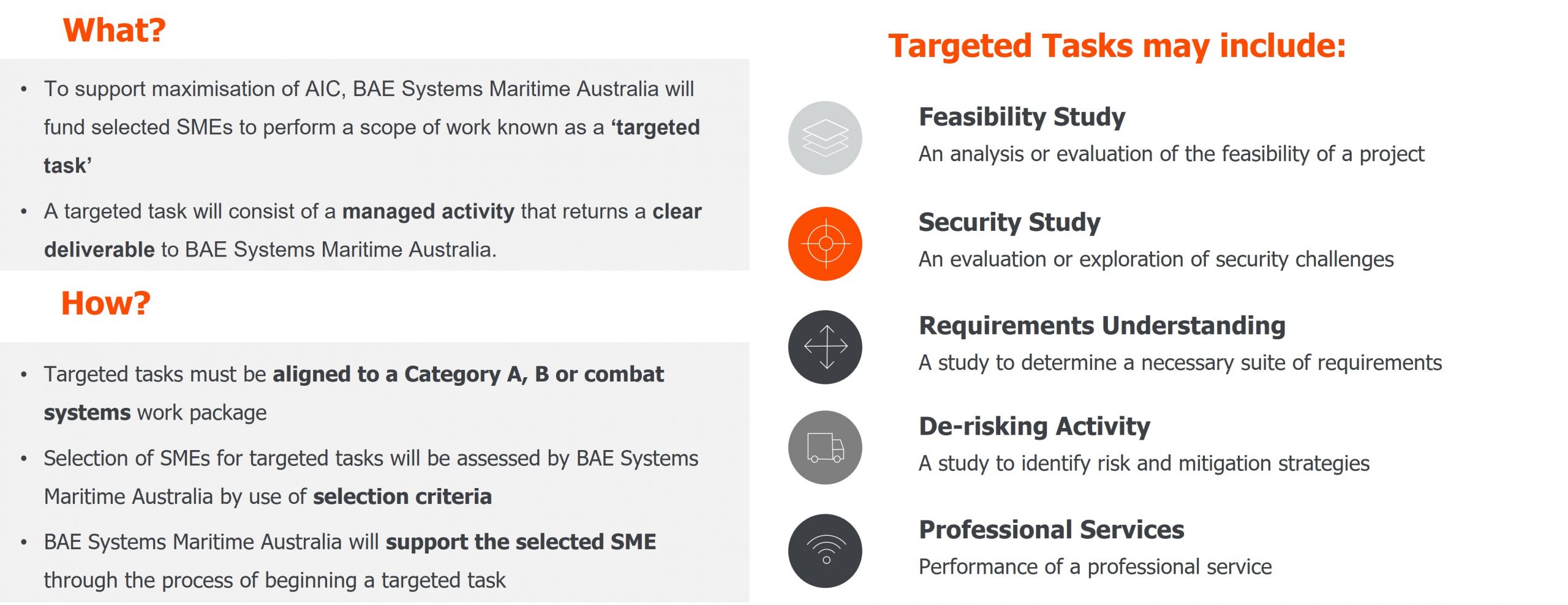
- Targeted Tasks can support OEMs and Australian SMEs to work together to support procurement activities across the Hunter Supply Chain (Cat A, B, C, D and Combat).
- The Targeted Task will provide a clear deliverable in support of the feasibility and assessment of the OEM investment cases where:
- The SME is already in discussion with the OEM; and/ or
- The SME has facilities capable of producing the equipment; and/ or
- The SME has a successful track record (based on BAESMA industry knowledge).
- The Targeted Task presents an opportunity ‘on the surface’ to increase AIC but requires further validation;
- The Targeted Task clarify opportunity specific implications required for HCFP benefit (such as facilities, tooling, certification, security etc.);
- The Targeted Task will have the potential to deliver an AIC/CNS outcome for the specified equipment; and
- The Targeted Task will clarify transfer of technology/knowledge scope including elements such as cost, outputs and/or maximising AIC.
Category Definitions
Category A
- High value, high risk, project-specific equipment; very large and complex systems
- Customer-mandated, program-critical (mini projects), competition-led
- Major equipment, e.g. power and propulsion and complex systems.
Category B
- Medium value, established and medium to low risk equipment
- Complete systems that have been modified for the program, although they remain recognisable as the original equipment or system
- Platform equipment.
Category C
- Catalogue items and commodities, consumables
- Platform supplies (build to print or Commercial-off-the-Shelf (COTS))
- Catalogue equipment or commodity materials which are generally built to print or proprietary, with high volume but low individual value and risk
- Commodities: steel, valves, pumps, electrical systems, pipe materials.
Category D
- On-site subcontracted services that are: program critical, intrinsic linkage to build program, service to the project
- Subcontract services.
Combat Systems
- The system providing the combat and defensive capabilities of a ship including navigation systems, internal and external communications systems, command management and direction systems, various sensor and effector capabilities together with associated computer networks.
OEM Category A&B combat systems Equipment list
| Equipment | OEM | Equipment | OEM |
| Gas turbine Enclosure Package & Integration | Rolls Royce | Composite Armour | Plasan Sasa |
| Mission Bay Handling System | Rolls Royce | Ships Lift & Hoists | Babcock Pty Ltd |
| Shaftline System | Naval Group | Solid Waste Treatment Plant | Ompeco |
| Wholeship Pumps | DESMI Limited | Hull Vibration Monitoring Equipment | Hottinger Bruel & Kjaer |
| Hot fresh Water Module | DESMI Limited | Main Hangar & Mission Bay Hangar Closures | Calzoni |
| HP Commpressor and BA Equipment | Sauer / Penske PS | Flexible Driveshaft Coulping | Renold Hiltec Couplings |
| Diesel Engine &Genset | MTU-F / Penske PS | HelicopterX/Y Gantry rane 1.5te | MST |
| HVAC & ATU Condensate Transfer Unit | Aerius Marie GmbH | WT & GT Doors, Hatches & Scuttles | MST |
| LED Light Fittings | Redarc | Hull Preservation System | Cathelco |
| Gearbox Lubricating Oil Cleaning Module | GEA Mechanical Equipment UK Limited | Composite Mast & Structural Components | Umoe Mandal A/S |
| Dieso Fuel Filtration | GEA Mechanical Equipment UK Limited | RAS Sliding High Point | Kongsberg |
| Ships Windows & Window Wipers | TBC | Propellers & Brake Blades | Kongsberg |
| Sewage Treatment Plant | Detegasa | Steering Gear System | Kongsberg |
| Oily Water Separator | Detegasa | Fin & Hull Plate Stabilisers | Kongsberg |
| LV Electrical Package Switchboard | RH Marine BV | Fixed Fire Fighting System | Tyco Fire & Integrated Solutions |
| Helicopter Handling Systems ASIST | Curtis Wright – Indal | Fire Smoke & Flodd Detection | Tyco Fire & Integrated Solutions |
| HP Air Receivers | Chestfield Special Cylinders | Shared Infrastructure | BAE Naval Ships |
| Wholeships Valves, Actuators & RVO’s | Score Marine | Ship Integrated RADIAC System | Ultra |
| Propulsion Gearbox | David Borwn Santasalo | Visual Surveillance System | Anschutz |
| Power for Helicopter Starting | Whippendell Marine | Integrated Navigation & Bridge System | Anschutz |
| Liquid Strainers | Celeros | Communications System | Rohde & Schwarz |
| Propulsion Motors / Converter Drives | GE Power | Bow Sonar Dome | Tods Defence |
| RAS Stump Mast | Airspeed Pty Ltd | Hull Mounted Sonar & Torpedo Defence System | Ultra |
| Mission Bay Side Doors | TBA | Small Calibre Gun System | Rafael Advanced Defense Systems |
| Reverse Osmosis & Chlorine Dosing Unit | Salt Separation Services | Chilled Water Plant, Panels & Expansion Tanks | Johnson Controls International |
| Cold & Cool Rooms | Eernest West & Beynon | Anchor Handling System & Morring Equipment | Pellegrini Marine Equipment |
| Main & Intermediate Shaft Brackets | Goodwin Steel Castings | Platform Management System & Control & Instrumentation | L3 Harris |
| Commissariat Equipment | Barrier Arvitectural Services | MK45 Medium Calibre Gun | BAE Systems Inc. |
| Helicopter Visual Landing Aids | Aerionautical & General Instruments (AGI) | Torpedo Doors | Eurotorp |
| AVCAT Filter / ater Separator | PecoFacet | Blast Doors | Interdam |
| Dieso Fuel Coalescer | PecoFacet | Torpedo Launch System | Subject to Competition |
| Boat Bay Davit & RCS Screen | Pellegrini Marine Equipment | Electro-Optical Detector | Chess Dynamics |
| RCS Closures | Pellegrini Marine Equipment | Air weapons Handling System | Babcock Pty Ltd |
| Uptakes / Downtakes System | W.R.Davis | METOC | BAE Naval Ships |
| Mission Bay Handling Emergency Diesel Alternator Generating Set | Finning Ltd | Ship Installed Chemical System | Owen International / Bruker |
LlOYDS CERTIFICATION REQUIREMENTS
- One of the potential constraints of supplying product to OEMs for the HCFP Suppliers is the need for Lloyds certification
- Lloyds Classification is across all products within the ship build (Shipyard production, Welding, fabrication, Machining (roughing and final), Forging, Materials, Etc.)
- Suppliers may require some form of Lloyds certification which may include:
- Works Approval (for manufacturing facility & business, i.e. one off certification)
- Type Approval (may be used for mass production items i.e. valves)
- Component Certification (for all safety critical items – Witnessed by Lloyds throughout the manufacture)
- Lloyds do (generally) accept approval provided by another IACS agency (especially the further down the supply chain we slip)
- For suppliers selected by and OEM or down-selected for Cat C and D supplier ASC Shipbuilding will be undertaking a Supplier review and development program for that will:
- Identify suppliers that will require Lloyds certification
- Assist suppliers achieving the required certification by
- Conducting reviews of suppliers practices against Lloyds requirements
- Providing advise on modifications required
- Support modifications and certification by way of business improvement specialists resources and or financial support where required
HCFP – Supply Chain Security DISP Requirements
What is DISP?
- The Defence Industry Security Program (DISP) is managed by the Defence Industry Security Office (DISO) and supports Australian businesses to understand and meet their security obligations when engaging in Defence projects, contracts and tenders. It is a security vetting for Australian businesses.
The role of DISP is to help Australian Businesses
- Access the right security requirements when delivering Defence contracts and tenders;
- Access to Defence security advice and support services; and
- Better understand and manage security risks.
DISP provides confidence and assurance to Defence and other government entities (either Australian or foreign) when procuring goods and services from industry members
What is the requirement for suppliers intending to participate in Hunter Class Frigate Program with BAE Systems Australia?
- Pre contract – DISP Membership is not required, however it is highly recommended that DISP Membership is applied for at the earliest opportunity as the process can take some time.
- In contract – DISP Membership will be required dependant on the level of classification of information and/or assets being held.
How long will DISP Membership application take?
- Timeframes for processing DISP membership vary based on the required level of membership, current level of security maturity and requirements and dependencies on internal Defence resources. For more information on timing click here
What is the cost of DISP Membership?
There is no direct cost associated with DISP membership (ie. no membership fee), however, there will be costs associated with implementing and maintaining security measures to meet both initial and ongoing DISP membership requirements. These might include, for example, facility certification and accreditation, personnel security clearances, physical security measures.
- Businesses should consider these costs in relation to the level of DISP membership required prior to lodging an application.
- For further guidance or general queries on DISP membership, please visit DISP website or alternatively contact: 1800 333 362 or 1800 Defence
Contact BAE Systems Australia
BAE Systems Australia is continually seeking to connect with Australian & New Zealand industry who want to:
|
|
“We want to connect with you and your supply chain”
|

